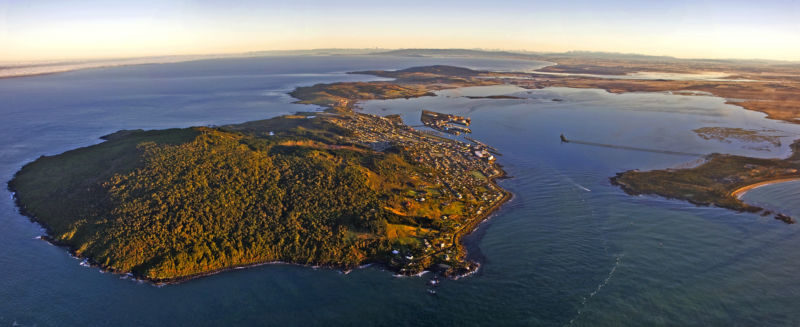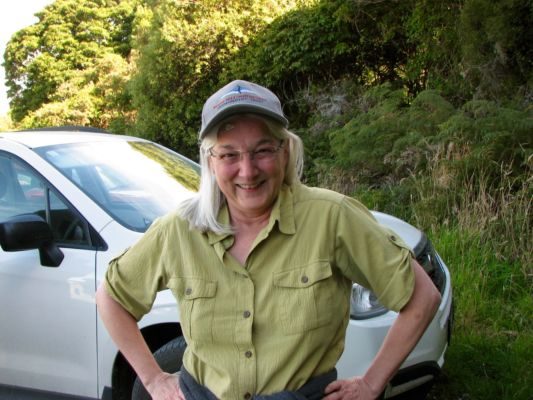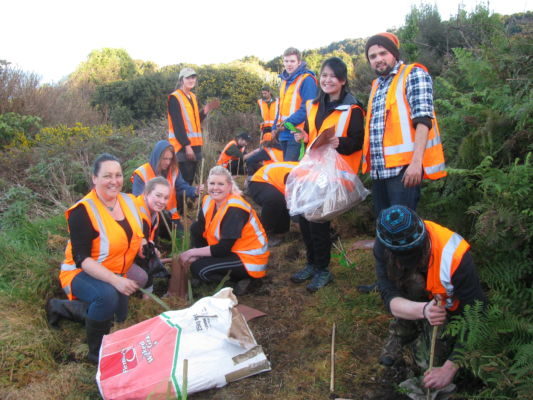Bluff Hill, at the southernmost tip of the South Island, is home to one of the few mainland colonies of titi/muttonbirds in New Zealand. Hundreds of birds have their burrows on the hillside and their arrival every evening and departure again at dawn makes for a spectacular sight.

But one dawn morning back around mid 2008 there was one titi that didn’t depart with the flock. Predators had got to it overnight and later that morning its damaged corpse was found by Bluff resident Chris Andrews.
Chris was so horrified by her discovery that she picked up the titi corpse, charged into town, marched into the local DOC office, threw the titi on the desk of DOC ranger, Colin Bishop and demanded to know what he was going to do about it.
Colin Bishop’s reply was apparently, “Well what are YOU going to do about it?”

And that, according to Libby Furr, is how the Bluff Hill/Motupohue Environment Trust began. Chris took up the challenge and, together with like-minded others, formed the Trust, which has been controlling predators on Bluff Hill and surrounding farmland since 2008.
Libby is currently Chair (Administration) for the Trust. It’s a busy and varied role in an organisation which relies 100% on volunteers. A key part of that role is to make it as easy as possible for those volunteers to do the predator control work and habitat restoration that’s needed to achieve the Trust’s goal: to provide an environment where native plants and animals are thriving – not just surviving – on and around Bluff Hill.
“I find ways to raise money, work with corporate sponsors and write applications,” says Libby. “My role is to ‘facilitate the ease’ of the volunteer work.”
So how did Libby get involved?
“I was a physicist in Mississippi, working in acoustics,” Libby explains. “When I retired, I moved to Bluff. I wanted to be of service in retirement, so I volunteered at the SPCA for a while. Then my husband, who knew the founders of the Trust, introduced me and I signed on to do a monthly mustelid line.”
From Mississippi to Bluff – from acoustics to stoats – Libby is clearly up for the challenge of an active retirement!
“Later the Trust got on shaky ground – there was a lack of administrative experience, so I stepped in as a trustee to help with that and eventually became Chair of Admin, which meant that I had sign-off on things,” Libby says.
These days the Bluff Hill/Motupohu Environment Trust is well supported by corporate sponsors, including Blacks Fasteners who are helping with the establishment of a native plant nursery and who recently helped fund a translocation of South Island robins to Bluff Hill. Southern Generation Limited is another corporate supporter. They contract Trust volunteers to carry out predator control work at their Flat Hill wind farm site at Greenhills, just outside the Bluff peninsula. The predator control contract is a classic win/win situation that not only provides additional funds for the Trust, but also helps to provide a buffer between the mainland and the Bluff peninsula, reducing the rate of reinvasion of possums and mustelids at Bluff Hill.
The group has worked very closely with the local DOC office ever since that initial unscheduled meeting over a dead muttonbird and Invercargill City Council is also a major financial supporter.
“Environment Southland was also very instrumental in getting the Trust started,” says Libby. “They continue to support us with funding and physical help and advice.”
Environment Southland staff carry out predator monitoring surveys on Bluff Hill in order to track the success of the Bluff Hill volunteers’ predator control efforts.
“We’ve got a high density of traps on the hill,” says Libby, “And our tracking stats are now low. Possums and rats are tracking at zero. That doesn’t mean we haven’t got any, but they are at very low density. We still constantly catch rats and mice, but stoats not so much now.”
In total there are 1,318 total pest control devices on and around Bluff Hill!
Titi are just some of the beneficiaries of their efforts. Red-crowned parakeets, fernbirds, yellow-eyed penguins, little blue penguins, South Island riflemen, kaka and Stewart Island shags can all be found on Bluff Hill, along with skinks, weta and other invertebrates. Weta footprints have been noticeably increasing in the tracking tunnels used by Environment Southland to monitor rats and mice.

The mix of wildlife hints at one of the features of Bluff Hill that makes it a particularly special place. It is one of the few remaining populated places in New Zealand where the forest goes all the way down to the sea. That forest is ancient – a podocarp/kamahi remnant filled with rata, rimu, miro and totara. It stands sentinel over one of the first European settlements in New Zealand. The first ship arrived at Bluff as early as 1813 and by 1824 the township of Bluff had begun to be settled.
Bluff Hill is a popular spot with present-day inhabitants – walkers, divers, fishermen and mountain-bikers. Nevertheless, there have been times when the Trust has struggled to get enough volunteers.
“The hardest thing is to keep the volunteer base,” says Libby. “We have a good mix of about 20-25 people, many retired and we’re usually lucky at getting new people when we need them. We try to match volunteers with tasks that they enjoy that fit the time they have available, so that they will stay longer.”
The shortest trapline takes an hour to rebait, check and clean.
“Some lines take 2-4 hours,” says Libby. “We are always looking for ways to make predator control easier. We’ve looked into fencing and other developing techniques such as trap networks and acoustic deterrents. Bluff Hill is a venture in perpetuity, so we’re looking for techniques that are beneficial in the longterm.”
Encouraging participation by young people is one way to help ensure the longterm future of Bluff Hill’s forest and marine life. The Bluff Hill/Motupohue Environment Trust works closely with the Southern Institute of Technology’s ‘Environmental Management’ programme.
“Once a year environmental management students are hosted at the local marae and work on a restoration project on a plot of land at Bluff Hill, getting rid of pest plants and putting in natives,” says Libby. “And on and off through the year we get SIT students from all courses looking for something to do and volunteering for us.”
Individual SIT students also use Bluff Hill as the base for study projects.
“One of the environmental management students is currently doing his project on Bluff Hill’s little blue penguin colony,” says Libby. “It’s not really been studied previously and he’s doing a full investigation into nesting, predators and whether trapping is making a difference.”
The main focus for the immediate future is to fine-tune and increase pest control.
“We’d like to find new ways to stop predators coming in,” Libby explains, “sensors, acoustic methods of repelling…”
Another key ambition for the future is to establish a native plant nursery to raise plants for Bluff Hill restoration and also to supply other volunteer conservation groups in the region.
“For a number of years our native plant nursery has been in the back yard of Estelle Leask, who has been with the Trust since it began,” says Libby. “Currently she has 400 plants ready for two planned restoration projects. A few years ago, she grew 2000 plants!”
Work on establishing a new nursery has already begun.
“We’ve bought a residential section, cleared the land and got rid of an old building,” says Libby. “Next we need to get land use consent. Then building consent will be needed.”
The paperwork required can make for a long process.
“We plan to use shipping containers,” says Libby. “It will be designed to look like a park with landscaping done in native plants to hide the containers. That way the neighbours will get to enjoy it as well.”
Other plans for the future include more translocations of native species back to Bluff Hill.
“With the support of local rununga and DOC we released 41 South Island robins in early March,” says Libby. “Estelle Leask is in the environmental management programme at SIT and she’s monitoring the robins as part of her studies. Maybe we could release saddlebacks in the future. It depends on DOC and on the birds’ vulnerability.”
More monitoring is also on the wish-list for the future.
“We’d like to increase non-pest species monitoring,” explains Libby. Environment Southland does bird counts, but we’d like to have insect monitoring and reptiles too. Eventually we’d like to have guided walks, with markers around plants and trees, guided viewings of titi in the morning and evening… building local tourism and boosting the Bluff economy.”
The Trust has plenty of ideas for ongoing projects, but they’re not rushing the process.
“It’s important to go slowly,” Libby believes. “We need to let nature have time to adjust to the changes we make. It is a lovely place. You get a good sense of peace and beautiful nature around you,” she continues. “We want to make Bluff Hill a special place to visit and learn about nature and learn how to take time so nature has a chance to respond.”
Change is already visibly happening as nature responds to the decrease in introduced predators.
“Back in 2009,” says Libby, “You could see through the trees for a long distance. Now you can’t see at all. There’s no possum browse and the forest floor is teeming with goodies! We’d love to find someone to monitor the flora and the forest floor.”
An opportunity for a new volunteer, perhaps…
Tip to share
Bluff Hill/Motupohue Environment Trust uses ditrac blocks in their ‘Pied Piper’ bait stations, now that their rat-tracking stats are low. Although the bait stations are made for pindone pellets – which rats like – it deteriorates quickly. Pindone is better suited to a much higher density of rats than is present at Bluff Hill, they reckon.

